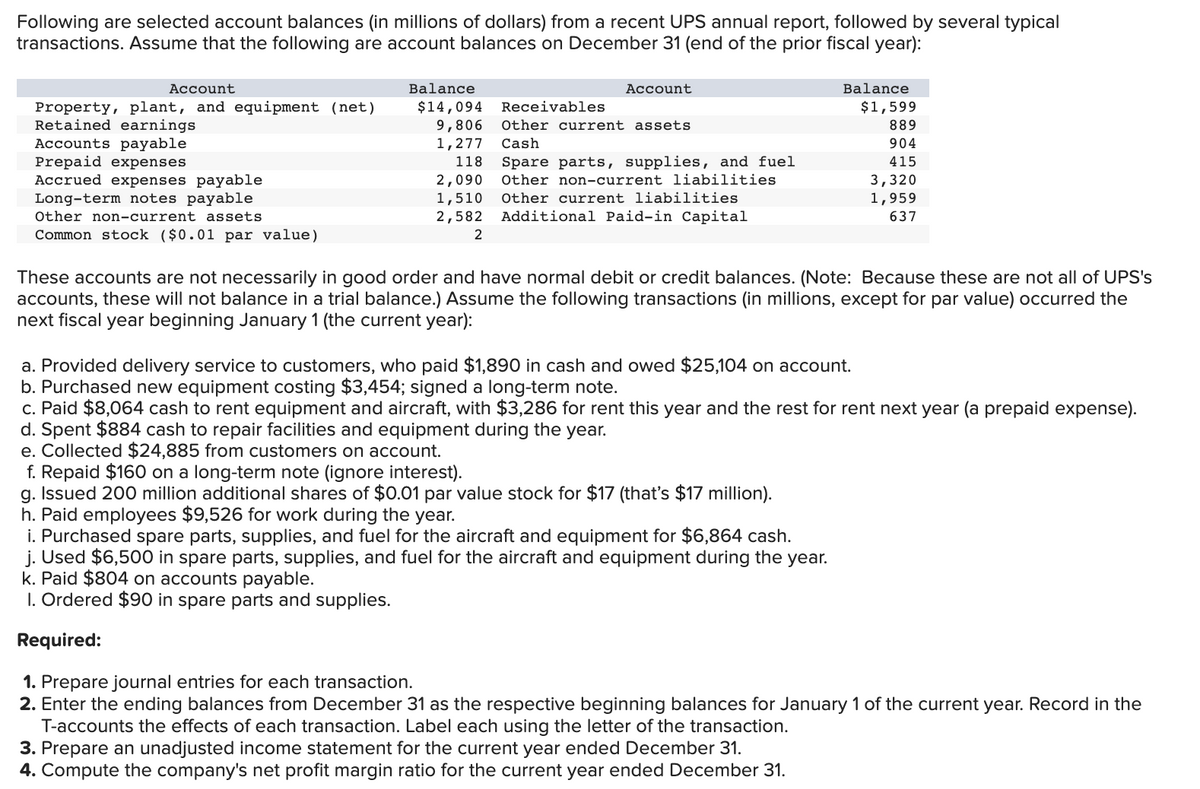Following are selected account balances (in millions of dollars) from a recent UPS annual report, followed by several typical transactions. Assume that the following are account balances on December 31 (end of the prior fiscal year): Account Property, plant, and equipment (net) Retained earnings Accounts payable Prepaid expenses Accrued expenses payable Long-term notes payable Other non-current assets Common stock ($0.01 par value) Balance $14,094 Receivables 9,806 Other current assets. 1,277 Cash 118 Spare parts, supplies, and fuel 2,090 Other non-current liabilities 1,510 Other current liabilities 2,582 Additional Paid-in Capital 2 Account Balance f. Repaid $160 on a long-term note (ignore interest). g. Issued 200 million additional shares of $0.01 par value stock for $17 (that's $17 million). h. Paid employees $9,526 for work during the year. i. Purchased spare parts, supplies, and fuel for the aircraft and equipment for $6,864 cash. $1,599 889 904 415 These accounts are not necessarily in good order and have normal debit or credit balances. (Note: Because these are not all of UPS's accounts, these will not balance in a trial balance.) Assume the following transactions (in millions, except for par value) occurred the next fiscal year beginning January 1 (the current year): 3,320 1,959 637 a. Provided delivery service to customers, who paid $1,890 in cash and owed $25,104 on account. b. Purchased new equipment costing $3,454; signed a long-term note. c. Paid $8,064 cash to rent equipment and aircraft, with $3,286 for rent this year and the rest for rent next year (a prepaid expense). d. Spent $884 cash to repair facilities and equipment during the year. e. Collected $24,885 from customers on account. 3. Prepare an unadjusted income statement for the current year ended December 31. 4. Compute the company's net profit margin ratio for the current year ended December 31. j. Used $6,500 in spare parts, supplies, and fuel for the aircraft and equipment during the year. k. Paid $804 on accounts payable. I. Ordered $90 in spare parts and supplies. Required: 1. Prepare journal entries for each transaction. 2. Enter the ending balances from December 31 as the respective beginning balances for January 1 of the current year. Record in the T-accounts the effects of each transaction. Label each using the letter of the transaction.
Reporting Cash Flows
Reporting of cash flows means a statement of cash flow which is a financial statement. A cash flow statement is prepared by gathering all the data regarding inflows and outflows of a company. The cash flow statement includes cash inflows and outflows from various activities such as operating, financing, and investment. Reporting this statement is important because it is the main financial statement of the company.
Balance Sheet
A balance sheet is an integral part of the set of financial statements of an organization that reports the assets, liabilities, equity (shareholding) capital, other short and long-term debts, along with other related items. A balance sheet is one of the most critical measures of the financial performance and position of the company, and as the name suggests, the statement must balance the assets against the liabilities and equity. The assets are what the company owns, and the liabilities represent what the company owes. Equity represents the amount invested in the business, either by the promoters of the company or by external shareholders. The total assets must match total liabilities plus equity.
Financial Statements
Financial statements are written records of an organization which provide a true and real picture of business activities. It shows the financial position and the operating performance of the company. It is prepared at the end of every financial cycle. It includes three main components that are balance sheet, income statement and cash flow statement.
Owner's Capital
Before we begin to understand what Owner’s capital is and what Equity financing is to an organization, it is important to understand some basic accounting terminologies. A double-entry bookkeeping system Normal account balances are those which are expected to have either a debit balance or a credit balance, depending on the nature of the account. An asset account will have a debit balance as normal balance because an asset is a debit account. Similarly, a liability account will have the normal balance as a credit balance because it is amount owed, representing a credit account. Equity is also said to have a credit balance as its normal balance. However, sometimes the normal balances may be reversed, often due to incorrect journal or posting entries or other accounting/ clerical errors.
Hello, can I have help with creating a

Trending now
This is a popular solution!
Step by step
Solved in 4 steps with 3 images









